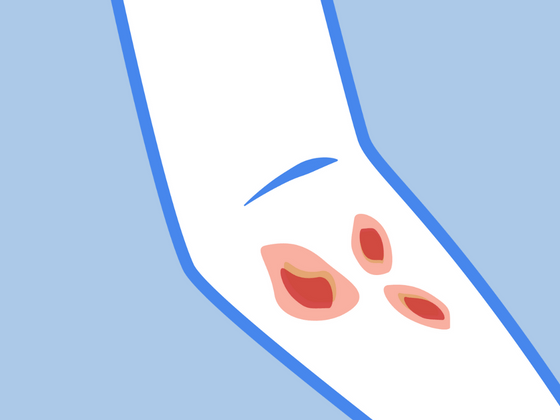As you may be aware, there are several different types of eczema, each with their own unique characteristics and healing stages. Because there is often a crossover of symptoms, it’s easy to confuse different types of eczema with each other. It’s also possible to confuse two different conditions, such as dermatitis herpetiformis vs. eczema herpeticum. In this post, we’ll explore the differences and similarities between dermatitis herpetiformis vs. eczema.
Please keep in mind that although these tips and information have worked for several sufferers, we are in no way medical professionals. If you’re experiencing severe symptoms or have a topical infection, it is always best to seek medical advice immediately.
What is Dermatitis Herpetiformis?
Dermatitis herpetiformis (DH) is an itchy skin rash that commonly occurs in people with celiac disease. Celiac disease is an auto-immune condition that makes it difficult for the body to digest gluten. Like eczema, DH often appears as raised red patches of skin that are bumpy and itchy.
However, it’s also known for causing blisters that resemble herpes. These blisters tend to develop on the elbows, knees, buttocks, and along the hairline. You’ll notice that the rash often appears on both sides of the body. It’s important to note that although the blisters resemble herpes, they do not come from the herpes virus. Rather, they are linked to gluten sensitivity.
Understanding Symptoms
In addition to the blisters, you may notice a burning or stinging sensation on your skin. You may also notice sores that look like hives. Because dermatitis herpetiformis is related to a gluten sensitivity, there are also digestive symptoms to look out for. These include abdominal bloating, diarrhea, constipation, and cramps.
Dermatitis Herpetiformis vs Dyshidrotic Eczema
What’s the difference between dermatitis herpetiformis and dyshidrotic eczema? After all, they both are characterized by intensely itchy blisters.
The blisters from dyshidrotic eczema usually develop across the fingers, palms of the hands and sometimes the soles of the feet. In more severe cases, the blisters may spread to the backs of the hands, feet and limbs. The other key distinction is that dyshidrotic eczema is not linked to a gluten sensitivity while dermatitis herpetiformis is.
Beat the Itch
To help beat the itch, we recommend using a natural cream and moisturizing often. We recommend this Organic Manuka Skin Soothing Cream because it’s made with just 6 ingredients, all of which are known for their soothing abilities. This oil-based balm is great for sensitive skin as there’s no burning or stinging. Plus, it’s safe to apply anywhere on the body from head to toe.
Dry Wrap Therapy
We recommend trying dry wrap therapy to help soothe any itchiness, inflammation, and discomfort. Dry wrap therapy is an easy at-home treatment that involves using a moisturizing cream, like the one mentioned above, and then covering up with a protective layer. The process helps the cream permeate the skin better which provides a more effective and efficient treatment compared to using the cream alone.
For hard-to-reach areas, such as the elbows and knees, we recommend these Remedywear™ Sleeves for babies to adults. Made with TENCEL and embedded with anti-inflammatory zinc, they’re super soft and comfortable.
Try a Gluten Free Diet
Finally, to help heal from within, we recommend trying a gluten-free diet. This involves removing all gluten-containing foods from your diet. Gluten is a protein typically found in wheat, barley, and rye. Before undertaking any dietary changes, please speak to your doctor or medical professional first to make sure this is the right step for you.
References
https://celiac.org/about-celiac-disease/related-conditions/dermatitis-herpetiformis/
https://www.webmd.com/skin-problems-and-treatments/what-is-dermatitis-herpetiformis
https://www.nhsinform.scot/illnesses-and-conditions/skin-hair-and-nails/dermatitis-herpetiformis
------------------

Bio: Kazandra is a contributor and content developer for The Eczema Company with a flair for creative storytelling rooted in strategy. Her comments, suggestions, and reflections are not intended to replace any medical advice. Always seek the help of a medical professional before undertaking any diet or lifestyle changes.








